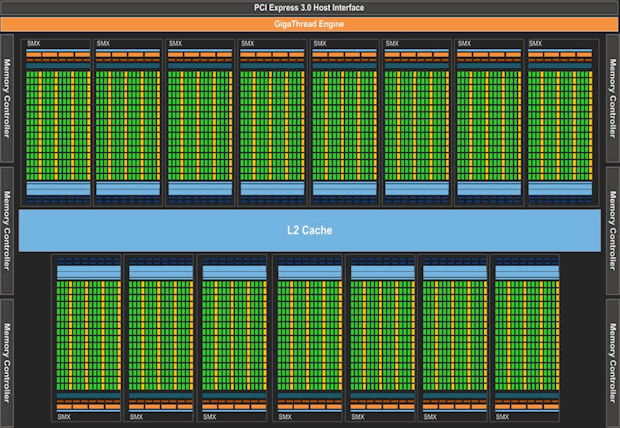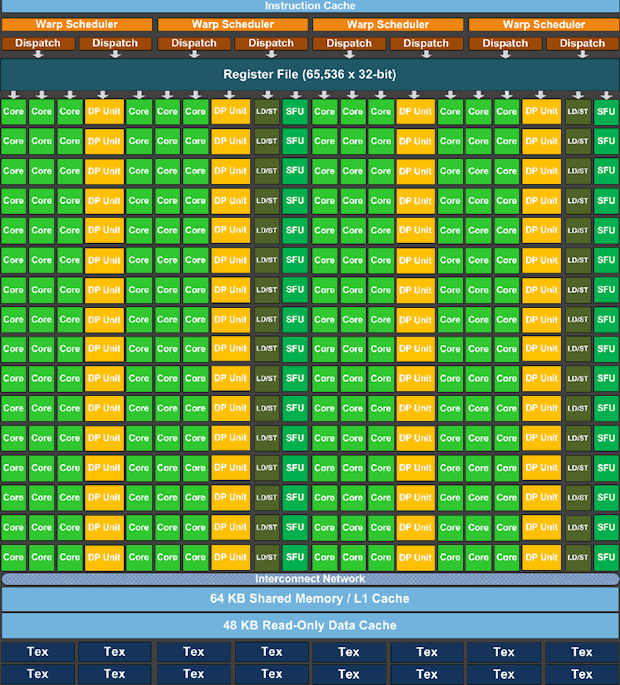Kepler GK110 Revision B Graphics Architecture
Kepler GK110 Revision B Graphics Architecture
As you can understand, the massive memory partitions, bus-width and combination of GDDR5 memory (quad data rate) allows the GPU to work with a very high framebuffer bandwidth (effective). Let's again put most of the data in a chart to get an idea and better overview of changes:
| Graphics card | GeForce GTX 680 | GeForce GTX 780 | GeForce GTX Titan | GeForce GTX 780 Ti | GeForce GTX Titan Black | GeForce GTX Titan Z |
| Fabrication node | 28nm | 28nm | 28nm | 28nm | 28nm | 28nm |
| Shader processors | 1536 | 2304 | 2688 | 2880 | 2880 | 5760 |
| Streaming Multiprocessors (SMX) | 8 | 12 | 14 | 15 | 15 | 15x2 |
| Texture Units | 128 | 192 | 224 | 240 | 240 | 240x2 |
| ROP units | 32 | 48 | 48 | 48 | 48 | 48x2 |
| GPU Clock (Core/Boost)* | 1006/1058 | 863/900 | 836/876 | 875/928 | 889/980 | 705/876 |
| Memory Clock / Data rate* | 1502/6008 | 1502/6008 | 1502/6008 | 1750/7000 | 1750/7000 | 1750/7000 |
| Graphics memory | 2048 MB | 3072 MB | 6144 MB | 3072 MB | 6144 MB | |
| Memory interface | 256-bit | 384-bit | 384-bit | 384-bit | 384-bit | 384-bit |
| Memory bandwidth | 192 GB/s | 288 GB/s | 288 GB/s | 336 GB/s | 336 GB/s | 336 GB/s |
| Power connectors | 2x6-pin PEG | 1x6-pin PEG, 1x8-pin PEG | 1x6-pin PEG, 1x8-pin PEG | 1x6-pin PEG, 1x8-pin PEG | 1x6-pin PEG, 1x8-pin PEG | 2x8-pin PEG |
| Max board power (TDP) | 170 Watts | 250 Watts | 250 Watts | 250 Watts | 250 Watts | 450 Watts |
| Recommended Power supply | 550 Watts | 600 Watts | 600 Watts | 600 Watts | 600 Watts | 850 Watts |
| GPU Thermal Threshold | 98 degrees C | 95 degrees C | 95 degrees C | 95 degrees C | 95 degrees C | 95 degrees C |
So we talked about the core clocks, specifications and memory partitions. Obviously there's a lot more to talk through. We feel that to be able to understand a graphics processor, you simply need to break it down into small pieces to better understand it. Let's first look at the raw data that most of you can understand and grasp. This bit will be about the Kepler GK110B architecture, if you're not interested in g33k talk, by all means please browse to the next page.
Right, so have a close look at the GK110 die as shown above. You'll notice the five green clusters. These are the polymorph GPC engines, each containing 3 SMX (streaming multi processor) clusters, 5 x 3 = 15 SMX clusters in total. You'll spot six 64-bit memory interfaces, bringing in a 384-bit path towards the graphics memory. That's instant extra memory bandwith by the way, combined with a 7 Gbps clock, the cards can reach 336 GB/sec.
So above, we see the GK110 block diagram that entails Kepler architecture. Let's break it down into bits and pieces. The GK110B will have:
- 5760 (GTX Titan Z), 2880 (GTX Titan Black),2880 (GTX 780 Ti), 2688 (Titan) or 2304 (GTX 780) CUDA processors (Shader cores)
- There are 192 CUDA cores (shader processors) per cluster (SMX).
When we zoom in even further at one SMX cluster (192 shader processors) we see a change from the GK104 (GTX 680) as there are 64 double-precision math units. See the GeForce GTX 680 SMX had 192 single-precision (SP) floating point CUDA Cores, and 8 double-precision (DP) CUDA cores. As a result, DP operations per clock ran at effectively 1/24 the SP rate. This is the same for GTX 780 Ti. The one exception remains the GTX Titan, it includes a full 64 DP CUDA Cores per SMX (compared to 192 SP CUDA Cores), or 1/3rd the number of DP cores to SP for substantially more double-precision horsepower. So based on a full 15 SMX 2880 shader cores chip the GK110 has 960 DP units linked to its total of 2880 CUDA cores, that would be 896 DP units on tested GTX 780 with 12 activated SMXes. Double precision wise, to unlock full performance, you must open the Nvidia Control Panel and navigate to “Manage 3D Settings”. In the Global Settings box you will find an option titled “CUDA – Double Precision” which needs to be enabled, but... GeForce GTX Titan and GTX 780 will run at reduced clock speeds when full double-precision is enabled. Still a great option if you are working on CUDA applications.
- GeForce GTX 580 has 16 SMX x 4 Texture units = 64
- GeForce GTX 680 has 8 SMX x 16 Texture units = 128
- GeForce GTX 780 has 12 SMX x 16 Texture units = 192
- GeForce GTX Titan has 14 SMX x 16 Texture units = 224
- GeForce GTX 780 Ti has 15 SMX x 16 Texture units = 240
- GeForce GTX Titan black has 15 SMX x 16 Texture units = 240
- GeForce GTX Titan Z has 2x (15 SMX x 16 Texture units) = 2x 240
So there's a total 15 SMX x16 TU = 240 texture filtering units available for the GK110 silicon itself (once all SMXes were enabled). Still with me?




